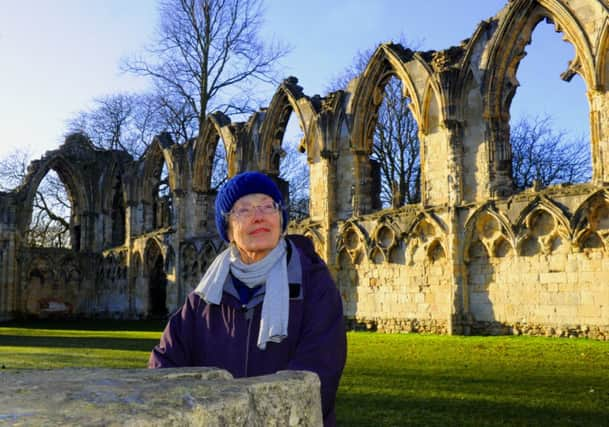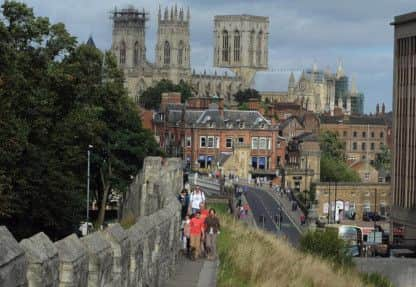Chapter and verse: A books’ tour of York


From being the birthplace of poet WH Auden to the home of the Mystery Plays, some of York’s literary connections are pretty well-known. Lynn Harper is a bit of an expert on both, but over the years she’s also amassed what can only be described as a mine of information on the city’s forgotten links to authors and writers whose work left a lasting impression on both literature and in the odd few cases changed the world.
Lynn works as a guide for York Walk, the company which runs daily themed ambles around the city, but during the annual York Literature Festival she gets to share her passion for books in a two-hour tour around the city’s most important literary sites.
Advertisement
Hide AdAdvertisement
Hide Ad“I’ve always loved books and the only problem with devising a tour like this is not what to include, but what to leave out,” says Lynn over a cup of tea in York’s central library, which will be the first stop on the tour. “Of course people want to see the birthplace of someone like Auden and every tourist who comes to York is keen to know more about the Mystery Plays, but at the end of two hours I also hope that they leave having discovered something new about the city and learnt about some less famous names.”


One of Lynn’s favourite stops on the tour is Dean’s Park next to the Minster. It was from here in 1639 that John Aston committed his thoughts about the city to paper. Fast forward a few centuries and much of what he wrote still rings true.
“There’s a lovely piece from him about looking over the city walls towards the countryside which stretched as far as the eye could see. Today that same view has become obscured by housing developments, but if you’ve ever been out in York late on a Saturday night his description of the people is pretty accurate. There’s a couple of lovely lines which describes York as home to people ‘affable and free-hearted’, but who ‘in their feasting... are very luxurious and given to excess’. I rather like that.”
Lynn’s tour winds its way from the Museum Gardens and takes in all the famous York landmarks from the Minster to the Art Gallery, York Theatre Royal and the Assembly Rooms as well as all the major literary genres.
Advertisement
Hide AdAdvertisement
Hide Ad“I hope there is something for everyone,” says Lynn, who is not one to indulge in literary snobbery, with one stop devoted to contemporary historical and romantic novelist Ann Victoria Roberts. “She has written a number of books set in York and they have been incredibly popular. I like to combine some of the history of the authors with readings from their work. Stood in a place where these authors lived, worked or visited and hearing their words read aloud really can transport you back a hundred years or more.”
Macbeth
One of the first stops on Lynn’s tour of literary sites is the Museum Gardens and more specifically St Olave’s Church, which has a direct link to both Shakespeare’s Macbeth and one of Britain’s most well-known nursery rhymes. Olaf was a Viking warrior who attacked London by boat in 1009, destroying London Bridge and providing the inspiration for London Bridge is Falling Down. The church is believed to have been founded by Earl Siward, a Danish warrior who arrived in England early in the 11th century and took control of the area which later became known as Yorkshire. It was inevitably a bloody rule and when his son was killed trying to wrestle power from the Scottish king Mac Bethad, Siward massed his troops and marched north of the border to finish the job. That battle and the Dane’s victory was recorded by Shakespeare 500 years later in Macbeth, earning Siward, whose heart was buried in the York church, a small, but significant place in English literary history.
Alcuin
Born around 735, Alcuin’s claims of being York’s earliest literary figure are pretty robust. A student of the then Archbishop of York, he was not only ambitious, but incredibly talented and was described as “the most learned man anywhere to be found” with good reason. He wrote a large number of theological treatises as well as poems, but it was as education officer for the whole of Europe that Alcuin made the biggest impact on the written word. “It was his idea to put a space in between words and he also introduced the use of capital letters,” says Lynn. “It’s incredible to think now, but before Alcuin had his brainwave when people wrote all the words would run into each other. He had to overcome some pretty substantial opposition because including spaces used up a significant amount more vellum which was incredibly expensive, but eventually he persuaded the great and the good that his way was the right one.”
Charles Dickens
The author of Bleak House and Great Expectations is rightly seen as one of English literature’s greatest ever authors. In the pages of more than a dozen novels he captured the inequality and hypocrisy of the Victorian age, but not even Dickens could get it right all the time. A frequent visitor to Yorkshire, his travels fed into much of his work, including a visit to York Minster which makes an appearance in Nicholas Nickleby. “Dickens refers to the Five Sisters Window, but the name is about the only thing he gets factually correct,” says Lynn. “Either he was using a little artistic licence or someone must have told him that at one point in the day the sun directly shines through the stained glass. Either way there is a whole section in the book describing the effect of the light, which he could never have seen.”
Laurence Sterne
Advertisement
Hide AdAdvertisement
Hide AdThe author of The Life and Opinions of Tristram Shandy, Irish-born Sterne became a vicar at Sutton-on-the-Forest a few miles from York and was a regular at the Assembly Rooms, which was at the heart of the city’s social scene during the 18th century. A bit like James Joyce and Ulysses, he was responsible for writing a book many have heard of, but few have read.
“Tristram Shandy is a devil of a book to read,” admits Lynn. “Whenever I take a tour I always ask who has tried to tackle it. A few hands will go up, but most confess to never finishing it.
“However, there is one story I love about Sterne. When he died his grave was apparently targeted by body snatchers who provided corpses for the local medical school to dissect.
“They were just about to open him up when some recognised him and the anatomy class was abandoned and Sterne was reburied in Coxwold.
Advertisement
Hide AdAdvertisement
Hide Ad“It’s a much quieter setting but I imagine he would have allowed himself a chuckle if he knew what had happened.”
Elizabeth Montagu
It was York-born Elizabeth Montagu who founded the influential Blue Stockings Society. Educated at Cambridge, the society was set up as an informal women’s social and educational movement in the mid-18th century. There are various stories as to how the group got its name, but one involves the botanist, translator and publisher Benjamin Stillingfleet who was invited to speak at the meeting of the society. Not rich enough to have the proper formal dress, which included black silk stockings, he turned up in everyday blue worsted stockings. The term came to refer to the informal quality of the gatherings and the emphasis on conversation over fashion and all future guests were asked to wear blue stockings rather than black. “Elizabeth always said that she didn’t have much time for marriage,” says Lynn. “But at the age of 22 she did get married to the Earl of Sandwich, a man of considerable wealth some 30 years her senior. Read into that what you will.”
Harriet Parr
Born in 1828, Parr worked as a governess before finding success as a writer with her first book, Maude Talbot, when she was in her mid-20s. From then until 1883, Parr produced approximately one novel a year, writing under the pen name Holme Lee. “Like many Victorian authors her name has largely been forgotten, but she received the ultimate accolade when Charles Dickens bought a number of her stories which ran in his weekly magazines. As well as writing a number of stories for children she also penned the hymn Hear My Prayer Heavenly Father which was printed in a number of hymn books both in this country and America.” She was also favourite author of the founder of Victorian London’s largest lending library, Charles Edward Mudie, “to whose sense of decency her fiction strictly conformed with its depictions of shy maidens and their decent love problems”.
• York Literature Festival will this year feature the likes of Dr David Starkey, Jenni Murray, Polly Toynbee and Helen Lederer. Various venues, March 19 to 29, www.yorkliteraturefestival.co.uk